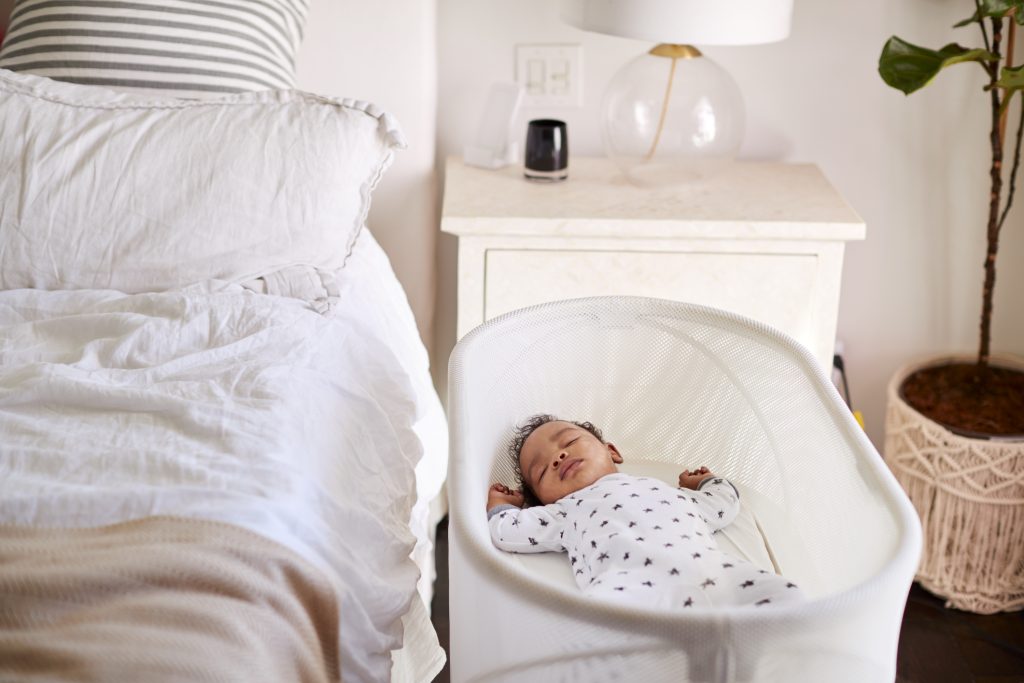Many new parents are filled with joy; all new parents are exhausted. The exhaustion can get worse when a newborn that once slept through the night stops “sleeping like a baby.” That’s where sleep training methods can come in handy.
Baby sleep training can help them sleep through the night without waking, crying, or needing you to soothe them. In this article, you will learn about seven different baby sleep training methods as well as tips on when to start and how to decide which training method might be best for you and your family. Soon enough your baby (and you) will be sleeping through the night!

Explore The Mother Baby Center blog for additional support and to learn more about your growing child.
What is sleep training?
Sleep training is a way to teach your baby to self-soothe and fall asleep on their own without help from their parent or caregiver. Through sleep training, they will learn to not only fall asleep but also to stay asleep on their own. There are many different ways to sleep train, and it may take a few tries to find one that works for you and your family.
Sleep training considerations
Experts typically recommend starting newborn sleep training after the 4th trimester, between 4-6 months of age. By 4 months old, most babies can sleep for six hours between feeds overnight. By 6 months, most children can sleep through the night.
If your baby is at the age you want them to be to begin sleep training, you’ll want to make sure you and your partner are also ready to begin sleep training. Discuss sleep training methods with your partner, and be sure you are both fully committed to making it work. It can be really challenging to adjust to sleep training for everyone and you will need to support one another. It can also be beneficial to consider joining support groups or speaking with a physician to learn more about what to expect during this transitional period.
Some factors to consider when deciding whether to sleep train your infant:
- Waking often in the night: If your baby is up throughout the night wanting to be soothed or are needing to bottle or breastfeed, it may be time to think about sleep training.
- Is your baby the right age: Your baby should be around the recommended age to start sleep training, which is 4-6 months old.
- Are you (and your partner) fully invested: Sleep training typically takes commitment and consistency from everyone because it can be emotionally and physically challenging. If you and your partner are not ready, that’s OK.
- Baby sleeps well: If your baby is already sleeping well, there may not be a reason to force training. If their sleep habits change you can always consider sleep training later.
Pros and cons of sleep training
The time it takes to sleep train a baby will depend on which method you decide to pursue and your baby’s unique needs and preferences. Typically, it will only take between three to seven nights to train your baby. Some parents experience a longer training timeframe, and that’s OK too.
In addition to the broad considerations to sleep training, there are some clearer pros and cons:
- Pro: Improve sleep habits.
- Pro: Babies learn to sleep through the night.
- Pro: Parents sleep more.
- Pro: Babies learn to self-soothe.
- Con: Takes time and effort.
- Con: Most babies cry during sleep training.
- Con: Parents may feel mean not soothing or helping their baby fall asleep.
- Con: Often adds stress to parenting partners’ relationship during sleep training.
Is sleep training harmful?
There is no research showing that sleep training is harmful. However, there are still a lot of two-sided conversations on the internet about sleep training babies. Some people say sleep training a newborn is incredibly important for babies and families.
Alternatively, some believe that sleep training is harmful and produces unnecessary stress for the infant. We have no evidence infant crying in sleep training causes harm, but it is a valid philosophical concern. This can be confusing and guilt-inducing to parents but know that you will always be an expert on your child. Sleep training infants using gentle sleep training methods can actually be quite beneficial for both babies and caretakers.
The anti-sleep training movement
Some people choose not to sleep train their baby or toddler for their own reasons. Every family is unique, and there are many ways to get healthy, restorative sleep.
While many people believe in the success of sleep training, some parents don’t. As mentioned, some feel it is harmful and don’t want to subject their children to the stress of sleep training. Some families also choose not to try traditional sleep training methods because they are practicing other methods of gentle parenting. Everyone is welcome to make their own choices surrounding sleep training and whether or not they want to take part in it.

Ensure your child’s health with a caring, and experienced physician, and find a provider today.
Reasons to sleep train
After families and their babies have been home for a few months and adjusting to life in the world, there will still be many changes ahead. When your baby is around 4-6 months, you should begin to think about sleep training and which method you want to try. Sleep training can be successful in a short amount of time, sometimes as quickly as three nights! But, don’t stress, if it takes longer, that’s OK too.
Here are five reasons to sleep-train your baby:
- Improves baby’s sleep: Once a baby is sleep trained, they oftentimes sleep through the night leading to improved sleep overall.
- Babies learn to self-soothe: When a baby wakes up, they may cry because typically when awoken, they have a parent there to hold them, cradle them, and soothe them. But, babies can actually soothe themselves just as well.
- Babies learn to sleep through the night: While babies may stir throughout the night, after being sleep trained, they self-soothe and then head right back to sleep. This may happen throughout the night but there are no more moments where they need to be taken out of their crib and cared for, they simply stay resting all night.
- Improves parents’ sleep: When a baby sleeps through the night, parents can too! There is no more waking up to feed, soothe, change diapers, etc. You can simply go to sleep, stay asleep and wake up when the baby awakens in the morning!
- Less stress on parents: Waking up throughout the night causes less sleep and less sleep can lead to stress. If sleep trained, the baby shouldn’t need you throughout the night leading to a restful night’s sleep for parents.
Sleep training methods
There are many different types of sleep training methods out there. However, some of the most popular sleep training techniques are the fading method, the pick-up/put-down method, and the Ferber method. As you learn about each one, imagine you and your partner doing it. If one method feels like it won’t work for you, that’s OK. There are many methods to try and it may take a few attempts to find one that works.
Ferber Method
The Ferber method (also known as controlled crying, “graduated extinction” or the check and console method) is named after the physician who developed this technique. This method involves putting your baby down for bed even if they are crying.
In this method, you allow your baby to cry and check in on them at set time intervals (e.g., every 5, 10, 15 minutes). These intervals gradually get longer, allowing your baby to do the work of soothing themselves. In this method, you are allowed to pat your baby or talk to them, but it’s not recommended you pick them up.
Chair Method
The chair method is sometimes called the sitback method. This involves putting a chair next to your baby’s crib. When you put them to bed each night, set them down in the crib and sit in the chair. Don’t leave the room until they are asleep. If they wake back up, go back and sit in the chair. Each night, you will move the chair back farther away from the crib. You will do this until the chair is out of the room.
This method is one that can be difficult for parents to succeed with as you have to watch your baby cry and not intervene and try to soothe them. This process may also take longer to see success.

Meet and connect with other families in support groups available through The Mother Baby Center.
Fading Method
The fading sleep training method is one of the best sleep training methods for some. To use this method, you take what techniques you normally use to get your baby to fall asleep – rocking, soothing, singing, babywearing, etc. — and you start to lessen the time you spend doing them to “fade” them out. This simply decreases the time a parent spends with a child when it’s time for bed.
The fading method is classified as a gentle sleep training method.
Pick-Up/Put-Down Method
The pick-up/put-down method is also classified as a gentle sleep training method. To do this method, you will put your baby down for bed and if they start to fuss, let it happen for a little bit. If they don’t seem to be settling down, go and pick them up and soothe them, then put them down (before they fall asleep in your arms). Repeat the process until they are asleep.
This method can take a long time to fully work and also requires a lot of dedication and patience.
Cry-It-Out Method (CIO)
The cry-it-out (CIO) method is one of the most controversial infant sleep training methods. That is because of how the method works: once you’ve gone through your normal bedtime routine and your baby is fed and safe, you put them down for bed and do not come back until morning, no matter how much they cry. This is particularly hard for the parents to endure all the crying and not be tempted to go into the room and soothe their baby. But some people see success after just a few days with this method.
Respectful sleep training
Respectful sleep training is another gentle sleep training method. This technique is used if you are not set on creating a strict routine for sleep training. Respectful sleep training involves creating a secure attachment with your child, responding to their cues, and helping guide them back to sleep. Because of this, this method takes longer and typically requires more time and commitment from the parents.
Customized sleep training
If you feel like you’re not sure which sleep training method is right for you and your family, you can turn to a sleep trainer or consultant for help. They can help create a customized method for you and help you pick what works best and what doesn’t seem to work. Ultimately, almost any sleep training method that is done consistently will usually be successful.

Follow The Mother Baby Center on Facebook for the latest news and tips.
Choosing the right method for you
Choosing the right sleep training method for babies and your family can be hard. It’s important to read through options and try and imagine yourself trying them. Which seems most realistic? Which will conflict most with your personality or parenting style?
You can always try one sleep training method and if it doesn’t seem to be working, learn about a new one. This process can sometimes be emotionally or physically tiring, so patience and support are important. You will eventually find a technique that works for you and your family.
When to seek professional help
Getting your baby to sleep can feel like an impossible task, and we hope some of these sleep training methods have given you hope. But, sometimes, even this doesn’t work. Maybe your baby isn’t responding to these methods and they aren’t getting much sleep, maybe it seems like your child simply doesn’t like or want to sleep. In either case, you’re not getting sleep either.
Fortunately, there are people you can work with who want to help alleviate your family’s restless nights.
Talk to your doctor
As always, you can discuss anything with your primary care doctor. If you’re wondering which method to choose, or maybe it doesn’t seem to be working, they can help. It’s also important to discuss how your infant sleeps because there may be other factors to consider such as allergies or sensitivities. No matter the circumstances, your provider can offer support or recommend specialists that can help.
Sleep trainer vs. sleep consultant
Most people do not know the difference between a sleep trainer and a sleep consultant. A sleep trainer typically uses sleep training methods with you and your child to help your baby get to and stay asleep. A sleep consultant typically will work with you beyond sleep training methods and consult you on different things you can try throughout the day and evening to help get your baby to sleep at night.

Every family is unique and parenting is not one size fits all. Find a physician for expert care through The Mother Baby Center.
Sleep training as your child grows
As your baby ages, their sleep habits will evolve and change over time. So, the methods and options you explore will depend on when you start to sleep-train your child. Our sleep cycles themselves also change as we grow up. Because of these changes, we must adjust how we react to our child waking in the night. It’s important to be prepared for those changes as your baby grows older.
What is sleep regression?
Sleep regression is when your baby once slept well and now has trouble falling or staying asleep. This can happen at any age! Sleep regression can be temporary, so there is still hope of getting them back to sleeping through the night.
There tends to be an association with age and milestones/development of your child. For example, when a baby learns to crawl or walk, they may also experience a sleep regression.
Sleep training for newborns
Because people typically start sleep training infants around 4-6 months of age, the methods may differ from sleep training a toddler. An infant’s sleep cycles are typically between 20-50 minutes. They may slightly stir after that cycle ends but then soothe themselves back into the next sleep cycle. And then, repeat. When sleep training an infant it is common to have to manage and train more overnight awakenings because of these shorter sleep cycles.
Sleep training toddlers
Sleep training toddlers often requires more flexibility and creativity on the part of their parents for a variety of reasons.
Toddlers’ increased verbal and creative play can lead to intentional methods for delaying bedtime or returning to sleep. Some toddlers may simply be too excited and curious about what’s happening outside their room to want to sleep. Because toddlers are older, they can also develop fears which may involve comforting them at night if they wake. Sleep patterns can also change if you are crib-training your toddler.
Reducing the length of naptimes or reducing the number of naps taken during the day can help alleviate restless nights.

Even after baby arrives, find support and care through The Mother Baby Center.
Tips to help sleep training
There are some common aids to help the sleep training process go smoothly for the whole family. The most helpful habit is creating a routine. Consistent sleep and wake windows can help you succeed in sleep training your baby.
However, each family is different. Some tips and aids may help some families while they may not help or be applicable to others. For example, flexibility may not be possible for some families at the beginning of sleep training and they may need to simply stick to consistency for a while.
- Create a routine: Build a bedtime routine for your child. Try and do the same routine each night so they get the hang of it. For example, start bath time at the same time every night, then get their pajamas on, then read a book, then it’s bedtime.
- Be flexible but consistent: Consistency is important when sleep training but as we all know, life happens. Maybe you’re going on vacation which is great! Just try and maintain your sleep training schedule and bedtime routine as best you can.
- Learn about wake windows: Wake windows are times when you want your infant to be awake for a long enough period before their next nap, but not too long that they become overtired and crabby. Using the recommended wake window timing for your baby’s age will help with sleep training.
- Put the baby down while drowsy: When your baby shows signs of being tired, put your baby down for bed. That way they won’t get overtired by trying to stay awake when they are ready for sleep.
- Monitor your child’s health and comfort: There are some reasons why a baby may wake up throughout the night that is beyond sleep training. For example, they could be teething or growing, maybe their diaper needs changing, etc. These things may come up and your baby may need to be soothed or supported through these specific concerns.
- Do what’s best for your family: At The Mother Baby Center, we know that each family is unique. That’s why we also know sleep training isn’t a “one size fits all” situation, so always do what is best for you and your family.
Exceptional care for your growing family through The Mother Baby Center
There are plenty of different sleep training methods for you to choose from so explore some and try out others. At The Mother Baby Center, we want every family to be as healthy and happy as possible through every stage of growth. Pick your sleep training method as you see fit – or if you decide to skip sleep training, that’s OK too. You can find a primary care provider or pediatrician who will be willing to help navigate any challenges you experience.